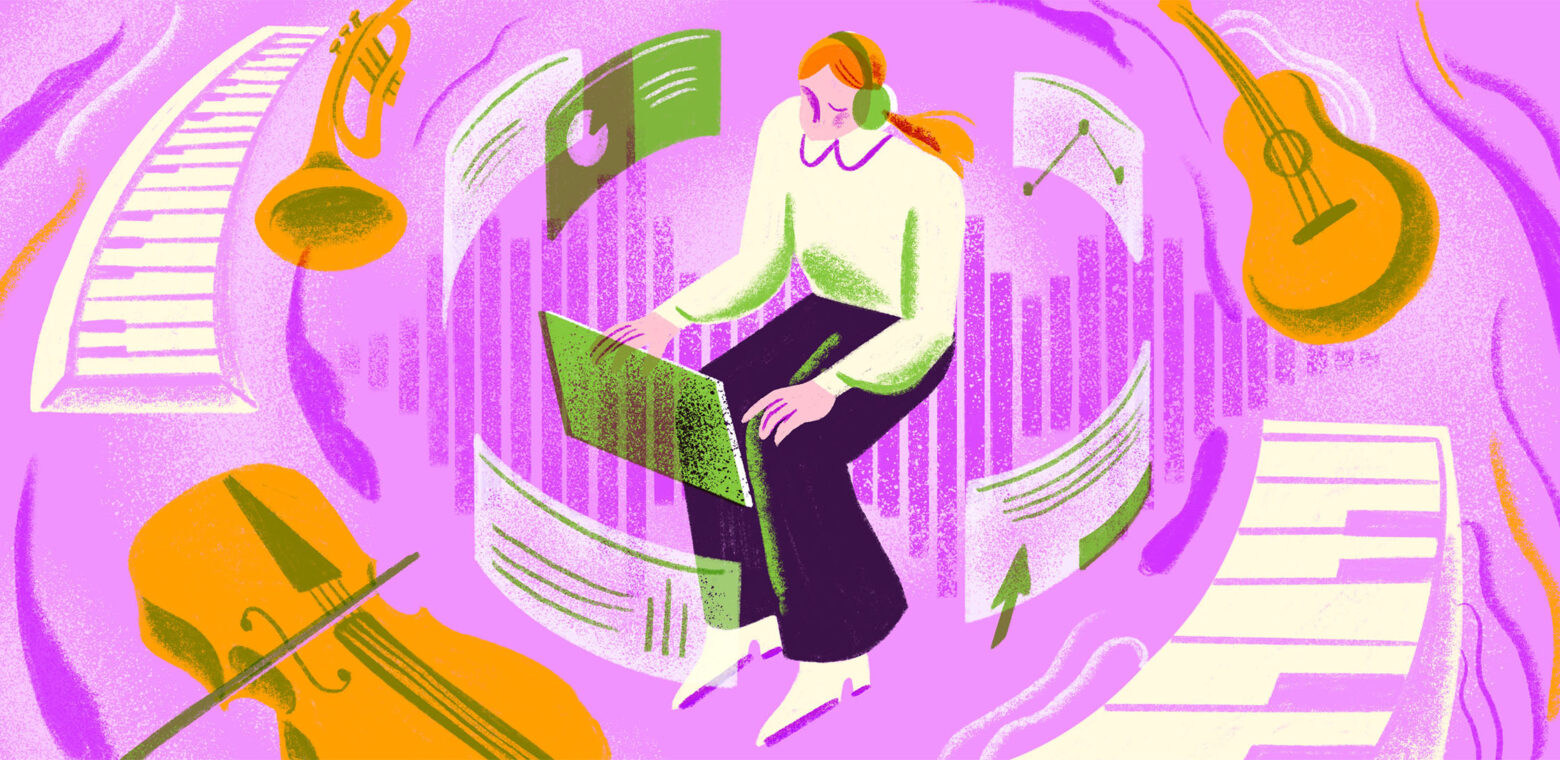Here on Work Life, we kinda live and breathe the practices and strategies that make teams happier and more productive. And music, in its various iterations, has long been known as a key instrument, if you will, of that coveted flow state we’re all after.
We pored over the research on which sounds are best for productivity, busting some myths and adding tracks to our playlists in several genres. So plug in your headphones we have a feeling you’re about to find your next favorite productivity playlist.
But first: what’s your go-to track for deep work? Let us know in the Atlassian Community – we’ll be adding some of your ideas to our productivity playlist!
Research and productivity playlists by genre
1. Classical
Maybe you’ve seen the countless “Mozart for babies” CDs claiming to make your newborn a genius. What’s with that? It’s known as the “Mozart effect,” a term that took off during the ’90s thanks to a single study published in the Nature journal in 1993.
In the research paper “Music and spatial task performance,” Frances Rauscher, Gordon Shaw, and Catherine Ky reported modest findings from their experiment with 39 college students: After listening to a Mozart sonata (K.448) for 10 minutes, the students scored significantly higher on spatial tests (they were asked to look at folded-up pieces of paper and guess how they’d look when unfolded). The effect—which the study authors did not call the “Mozart effect”—lasted 10 to 15 minutes.
These findings triggered a slew of inflated claims about Mozart’s music’s ability to increase intelligence. And while that’s a bit of a stretch, subsequent related studies do appear to show some promise.
For instance, a 2001 review of the literature found supporting evidence that listening to music by Mozart can improve short-term spatial-temporal reasoning, but not general intelligence. The researchers concluded that “an enhancement of spatial-temporal reasoning performance after listening to Mozart’s music for 10 minutes has been reported by several, but not all, researchers.” Further, patients with epilepsy have been shown to benefit from listening to Mozart’s K.448.
Mozart may not make you a genius, but it’s worth trying his genre of music next time you want to boost brainpower:
- Mozart – Sonata for Two Pianos in D, K. 448:The sonata that started it all. This is the exact piece played to participants in the original “Mozart effect” study.
- Mozart for Productivity: If you tire of K.448, this playlist broadens it to even more sonatas by Mozart.
- Classical for Productivity: Why limit yourself to Mozart? This Spotify playlist includes more of the greats, from Vivaldi to Beethoven to Bach.
2. Coffee shop sounds
If classical music isn’t your jam, tap into the power of the coffee shop effect. While the visual novelty that cafe-hopping provides can boost productivity, some research suggests the gains also have to do with sound.
How? Through a process known as stochastic resonance, a certain level of background noise can enhance performance—but at too loud of a level, it can decrease it.
A 2012 study published in the Journal of Consumer Research found that a medium-level of ambient noise from a roadside restaurant improved creativity, but low or high levels of it decreased it. The study authors note:
“Our findings imply that instead of burying oneself in a quiet room trying to figure out a solution, walking out of one’s comfort zone and getting into a relatively noisy environment (such as a cafe) may trigger the brain to think abstractly, and thus generate creative ideas.”
The right levels and types of sound vary widely depending on the person, but it could be the reason you find that background hum of chatter and clanging cups at a cafe so enticing.
Ready to find your happy medium? Give each of these coffee shop playlists a shot!
- 8 Hours of Rainy Night Coffee Shop Ambience: Light rain, smooth jazz, and an aesthetically pleasing scene combine to make this one of my favorites to listen to (and watch!).
- Coffee Shop Sounds for Study and Concentration: If you prefer a more lively atmosphere, this eight-hour track of real audio recorded from coffee shops is for you. Listen closely, and you might just catch humorous gems—like the guy at 4:29:50 who orders a “cold brew with nothing in it but 18 shots of espresso.”
- Coffee Shop Ambience Cozy Rainy Day: Soft chatter, raindrops falling, and the occasional clattering of cups make this one-hour audio enjoyable without being overwhelming.
3. Ambient music
The relaxing beats and soothing tones of instrumental ambient music make it a favorite pick for people who need to focus. In a 2021 Spotify survey of 4,000 adults in the U.S. and UK, 69% of respondents chose ambient music as the best for studying, with 67% saying that the key ingredient is the slower beats.
At the time of writing, these are the three most popular ambient music playlists in the Spotify Focus Hub:
- Deep Focus: “Ambient and post-rock music” to help you block out distractions and concentrate.
- Lofi Beats: Moderate beats that are both relaxing and engaging with few words (if any).
- Chill Lofi Study Beats: The name says it all. Instrumental easy-listening to keep your brain focused on deep work.
4. Upbeat tracks
Much of the research on the benefits of upbeat music centers around exercise. A 2020 study published in Frontiers in Psychology found that listening to high-tempo music (170-190 bpm) made exercise feel easier, and therefore, boosted performance.
Additionally, a 2003 study presented at an annual meeting of the American Association of Cardiovascular and Pulmonary Rehabilitation found that listening to upbeat music while pedaling on a stationary bike boosted participants’ exercise intensity; the faster the music, the faster they pedaled.
Could these findings from the exercise realm transfer over to desk-related tasks? Only one way to find out!
- 180BPM Instrumental: If you need high-powered music to boost productivity, this user-curated Spotify playlist brings the heat with a variety of instrumental tracks.
- Damo Running 180BPM (Instrumental): Want to feel like the hero running into battle at the climax of a movie? This might be the playlist for you. It consists mostly of Spotify’s “Epic” songs that are fast-paced, intense, and grand—but no distracting lyrics!
- 190BPM for Runners: And if you really want to step up the tempo, this playlist has lyric-free songs, all at 190 beats per minute to keep you pumped up without distractions.
5. Nature sounds
Few of us are able to go forest-bathing in the middle of our workday. But thankfully, merely listening to recordings of birds chirping and leaves rustling might be enough to soothe frayed nerves so we can dive into deep work.
A 2015 study by the Acoustical Society of America found that the sound of a flowing mountain stream boosted mood and productivity in workers in an open-plan office. The sample size was small, however, with only 12 participants.
Further, a 2017 study by the University of Sussex found that nature sounds can help you relax if you’re highly stressed. Interestingly, for participants who were already relaxed, listening to nature sounds actually increased their stress levels. So maybe skip these playlists if you already feel calm!
- Spring Morning Ambience with Lakeshore Water Sounds: A lake laps against the shore, and birds sing in the background in this relaxing eight-hour audio.
- Bluebell Woods – English Forest – Birds Singing – Relaxing Nature Video & Sounds: This three-hour track features plenty of birdsong and leaves rustling in the wind.
- Nature Sounds playlist by Spotify: This playlist has a variety of tracks with sounds from birds, rainfall, and rivers.
6. Pink and white noise
Noise colors refer to the power spectrum in a sound. White noise, for instance, plays all the frequencies at once at equal power, and it can sound more high-pitched than pink noise. Both noise colors may be beneficial for memory.
In a 2017 study published in Scientific Reports, participants who listened to white noise while learning new words had better recall than those who had learned the new words in silence. The researchers concluded that white noise might enhance the ability to acquire new words.
Pink noise has been shown to have memory-enhancing benefits, too. In a study published in Frontiers in Human Neuroscience, older adults who listened to pink noise while sleeping showed better word recall in post-testing.
According to psychiatrist Dr. Suruchi Chandra, administering pink noise via transcranial brain stimulation has shown promising results for her patients.
“Many of our patients have experienced improvements in several areas, including mood, motivation, focus, sleep, and brain fog,” Dr. Chandra writes on her blog. “Patients have often described a lifting of their mood and feeling happier and lighter, generally after the first 4-5 sessions of pink noise brain stimulation.”
Keep in mind that the pink noise Dr. Chandra writes about was delivered via electrodes placed on a person’s head. While you may not have access to that specific kind of therapy, giving pink noise a listen on Spotify can’t hurt!
- White Noise for ADHD, Focus, and Concentration: This Spotify playlist features more than just white noise. It also has brown noise (which has a deeper, rumbling quality) and airplane cabin noise (for those of us who miss travel!).
- Pink Noise Spotify Playlist: Pure and simple: Just 10 straight hours of pink noise to help you work (or sleep!)
What Deep Work author Cal Newport says about listening to music while you work
Since the term “deep work” was made popular by Cal Newport’s best-selling book of the same name, let’s find out his take on music’s effect on concentration.
“What I’ve learned is you have to train or habituate yourself to whatever the music type is,” Newport said in an interview with Author Hour. As an example, Newport spoke of an author who wrote a million words in one year while listening to Metallica.
“I’ve found this again and again,” Newport continued, “people habituate the different types of music, and then the actual content of the music doesn’t really matter. It’s the ritual they built up.”
In the same vein, music (especially a specific song, playlist, or genre) can serve as a cue that triggers a habit. As described by James Clear, a habit loop consists of:
- Cue
- Craving
- Response
- Reward
Like Pavlov’s dogs, we can train ourselves to react in a desired way to a specific cue (in Pavlov’s dog’s case, the mere sound of a bell was enough to make them salivate in expectation of food). So, in the same way that a dinging sound prompts you to check your iPhone or lying down in bed makes you feel sleepy, a song or playlist that you consistently work to may prompt you to “get in the zone” and be productive.
Productivity music: It’s in the ear of the beholder
Sorry, but there’s no magic playlist that’ll turn you into a productivity machine. Regardless, surveys show that people, by and large, enjoy listening to music while working. An Accountemps survey found that 71% of professionals believe they’re more productive when music is playing at the office, and in the Spotify survey mentioned earlier, respondents named audio as the number one productivity booster.
So while scientific research is rife with conflicting studies about productivity-boosting audio, one thing is clear: Whether it’s Mozart, Metallica, or some mix of your own making—if it works for you, play it!











































